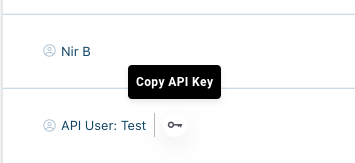Manage API Access
Fireblocks API Keys can be created via the web console or the API:
- For creating API keys via the console please check the following guide
- For adding additional API keys please refer to the following API endpoint
API Authentication
Fireblocks API involves a secure authentication process that should be followed both when creating the API key and when calling Fireblocks API with the created key.
The Fireblocks API uses an API key and a request signing process to provide a highly secure communication protocol.
The general process for creating the first API key is the following:
- Create an RSA4096 private key
- Run:
openssl req -new -newkey rsa:4096 -nodes -keyout fireblocks_secret.key -out fireblocks.csr -subj '/O=<your_organization>'
- Run:
- Generate a CSR file from the previously created RSA private key
- Browse to the Fireblocks web console and go to the Settings -> Users -> Add User -> API User
- Give the API key a name and choose the permissions for this key (same permission as user roles )
- Upload the generated CSR file
- Choose if Co-Signer setup is required
Once all of the steps above are done, and the relevant approval quorum was reached, the API Key will be ready in the Users tab and you copy the API Key value.

Every request with this API Key should follow the API Authentication scheme defined by Fireblocks.
Learn more about the required API Authentication here
API Keys Management Best Practices
Your API credentials and accounts are a prime target for hackers. It is important to understand and implement our best practices for working securely with the Fireblocks APIs.
Role-based access control
- When adding API users, ensure that the API user's role is provisioned in accordance with the least privilege principle. Fireblocks supports many different roles for role-based access control, and an API user can be any one of these.
- Create as many API users as needed to separate duties and create security boundaries.
Best PracticeIt is best to have 2 separate API users for different functions, such as:
- A 'Viewer' role that performs read-only operations.
- A 'Signer' role with transaction signing capabilities.
Create Policy rules for API users
API Users with transaction initiation and signing capabilities are able to execute transactions like any other Fireblocks Console user.
It is imperative that you create strong Policy rules to govern what types of transactions these API users can conduct.
Best PracticeIt is best to create Policy rules that limit API users to transact from a specific account and only up to a certain amount. This requires additional approvals or blocks the transaction, preventing users from trying to exceed the pre-defined amount or from transacting from an unauthorized vault account.
Whitelisting IP addresses for API requests
Each API user type on your workspace can whitelist specific IP addresses to only allow API calls from the provided address(es). If there aren't any whitelisted IP addresses for a user, API requests are possible from any IP address.
Address format requirementsOnly /32 IP addresses are accepted. Do not enter addresses as a range of values.
Best PracticeIt is best practice to explicitly whitelist the only IPs that you expect to be calling the Fireblocks API.
Generating & storing RSA 4096 private keys
Each API user requires a corresponding public/private key pair used to sign requests. It is imperative that you keep your Fireblocks Secret Key (fireblocks_secret.key) safe and secure.
Ways to keep your public/private key pair secure:
- Generate a unique CSR file and corresponding public/private key pair for each unique API user, such that if one API user's keys are compromised, other ones will not be.
- Generate the CSR file and corresponding public/private key pair in an offline (air-gapped) environment for added security.
- Ensure that your
fireblocks_secret.keyis stored securely in a hardened environment with advanced security controls such as multi-factor authentication and endpoint protection agents.
Do not embed API keys directly in code or your API code source tree
API keys embedded in code can be accidentally exposed to the public.
Best PracticeInstead of embedding your API keys within your applications, store them in environment variables or in files outside of your API code's source tree.
This is particularly important if you use a public source code management system such as GitHub.
Rotating secrets
Since there are two API users' use cases (Fireblocks API and co-signers), each use case has a different way to rotate the API users:
- Fireblocks API: Since it uses the CSR and the associated secret key, you need to create a new API user to rotate the users.
- Cosigners: Since it uses a one-time pairing token and it gives a refresh token to get an access token, the rotation here is to re-enroll the API user to get a new pairing token, and then you do the pairing to get a new refresh token.
- Fireblocks Agent for KeyLink: It uses the pairing token, access token, and device. It does not have the MPC keys.
Best PracticeBefore you begin, use the Get all API keys endpoint to view all the API keys paired to a specific API Co-Signer in a paginated list.
Updated 30 days ago